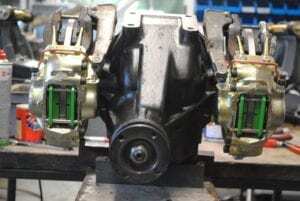Powertrain differential – you are the weakest link!
- 15th December 2016
- Technical
- Posted by kwecars
- Leave your thoughts
While external crash damage to a vehicle is clearly noticeable, other parts are less so and therefore require thorough checks and repairs before a car is deemed roadworthy and safe to drive.
A car’s powertrain comprises several important components that are prone to serious damage if a vehicle is unfortunate enough to be involved in an accident.
In most modern vehicles the powertrain includes the engine, transmission, drive shaft, differential and the final drive. Together, these components transmit the engine’s power through to the road surface.

Our workshop technicians have been kept particularly busy recently with two Jaguars XJSs that were both involved in serious accidents. In each vehicle, part of the powertrain (namely the differential), had suffered serious internal damage.
The differential allows the outside wheels of a vehicle to rotate faster than those on the inside while still transmitting power to both. This is necessary when a vehicle is required to turn, allowing the wheel that is traveling around the outside of the turning curve to roll farther and faster than the inside one.
(This fascinating video from the 1930s explains the principles of the differential gear)
In one vehicle, part of the gearing teeth on the differential had broken off causing a terrible noise as they were caught up in the mechanism; the other caused the limited slip clutches to fail resulting in one of the rear wheels to skid on every corner – unnerving to say the least!
Differential damage can be caused when a car is struck head-on or from the rear. When this happens, and the gearbox is in Park, the only thing stopping the car from moving away is the ‘tyre-wheel-halfshaft-differential-propshaft-gearbox’ chain. Surprisingly, the differential is the weakest link in this chain.
If the gearbox is not in Park, there’s usually enough inertia in the chain to result in damage caused by a strong collision, even before the wheels begin to roll forwards or backwards.
Our advice to you is that if you are aware that an unavoidable rear end shunt is about to happen, apply as much braking as possible while obviously paying due attention to your own personal safety, and to the safety of any passengers. This will, to a certain extent, protect the differential.
If you know, or suspect that your Jaguar XJS has been involved in a collision then it’s essential to have a thorough safety inspection carried out by expert technicians.
For all used classic Jaguar and Aston Martin cars, we carry out a comprehensive two-hour, on-site condition assessment. For more information, visit our website here.
Differing differentials
Unsure of your differential differences? We list the various specifications below, courtesy of jag-lovers.org.
Salisbury 4HU Powr-Lok
From 1976-1985, the differential was a Salisbury 4HU Powr-Lok that came with either 3.07:1, 3.31:1 (1976-1982), or 2.88:1 (1982-1985) ratios.
DANA
From 1985-1987, a 2.88:1 DANA unit was used for the V12. This unit can be distinguished in that the bearings on the output shafts are held in place with three bolts; the differentials both before and after these years have five bolts. It also has no drain plug.
GKN Power Lock
Beginning in 1987, there was a differential referred to as the GKN Power Lock with a 2.88:1 ratio.

